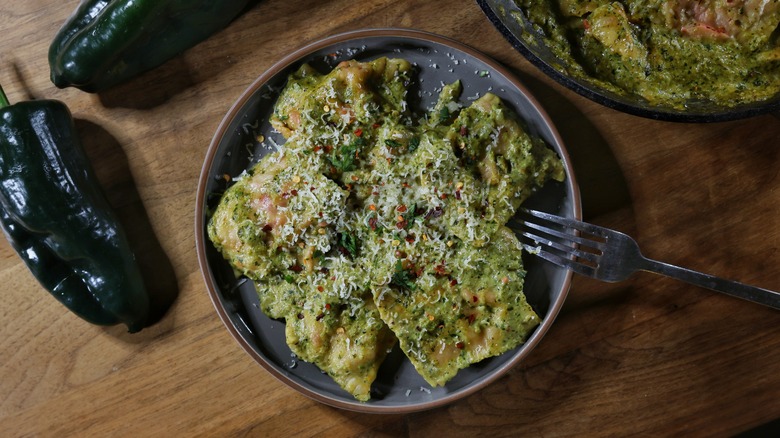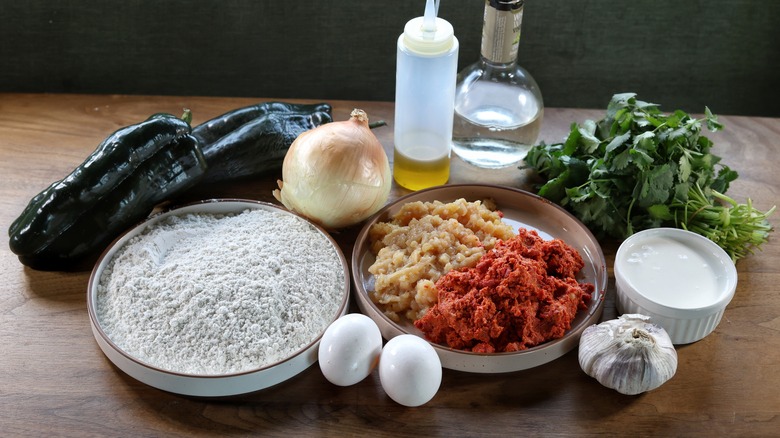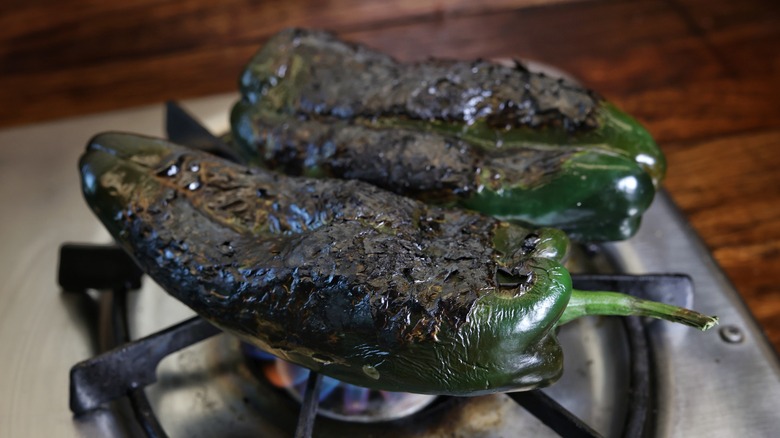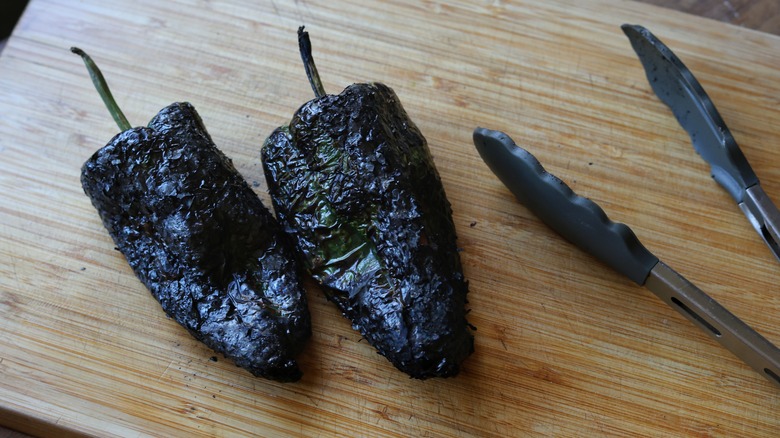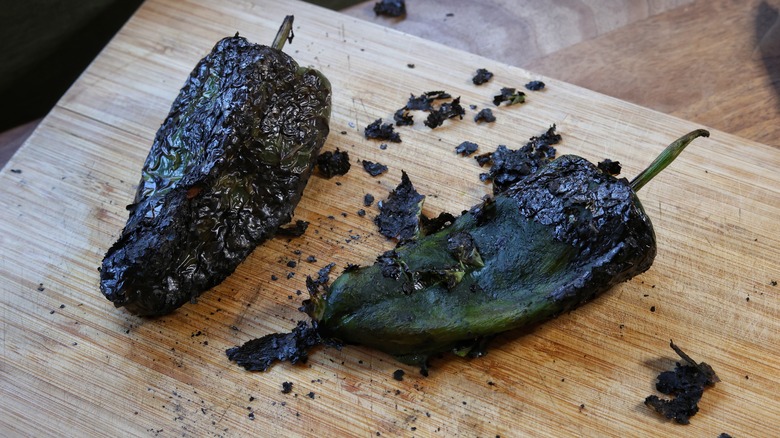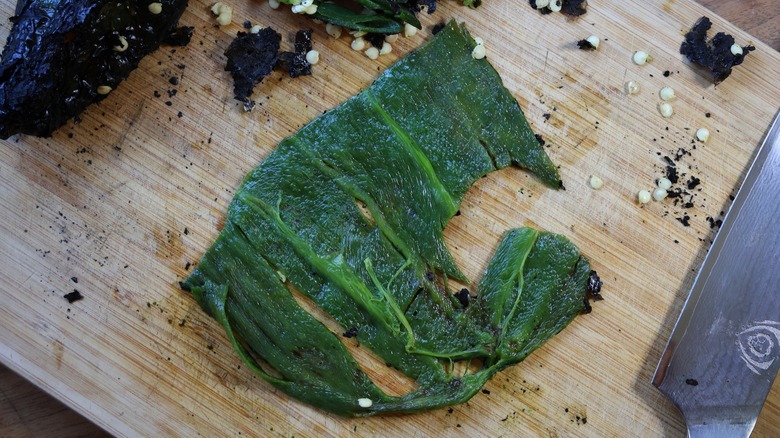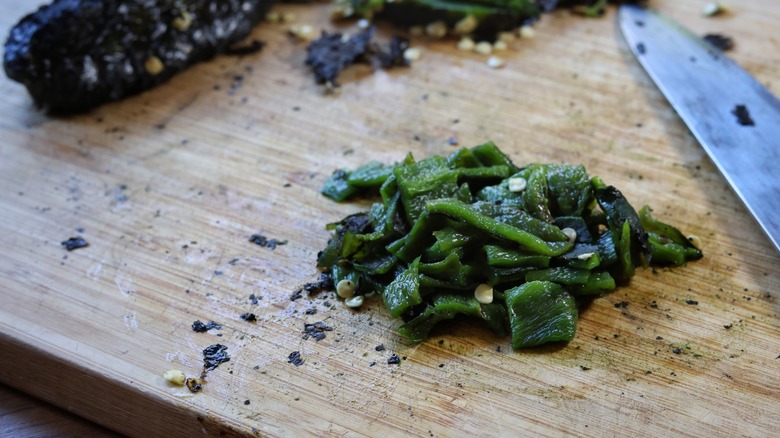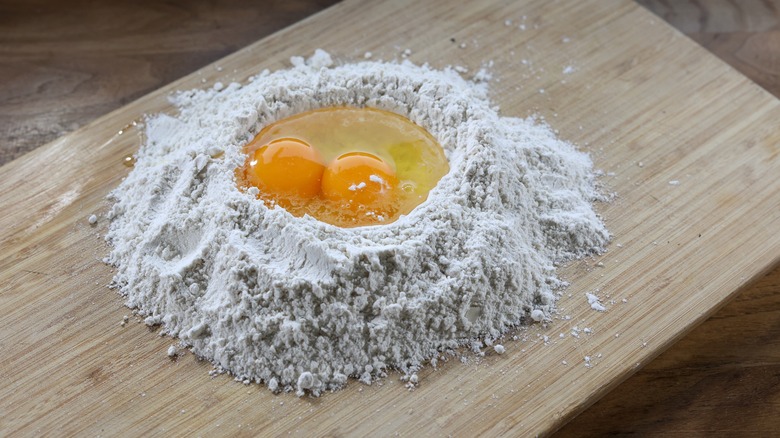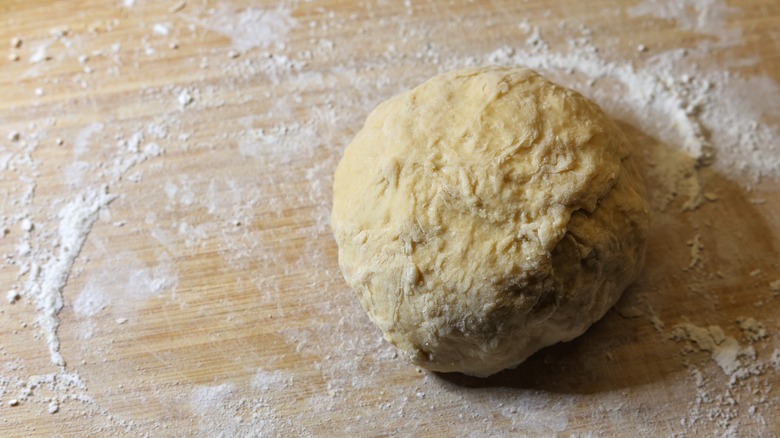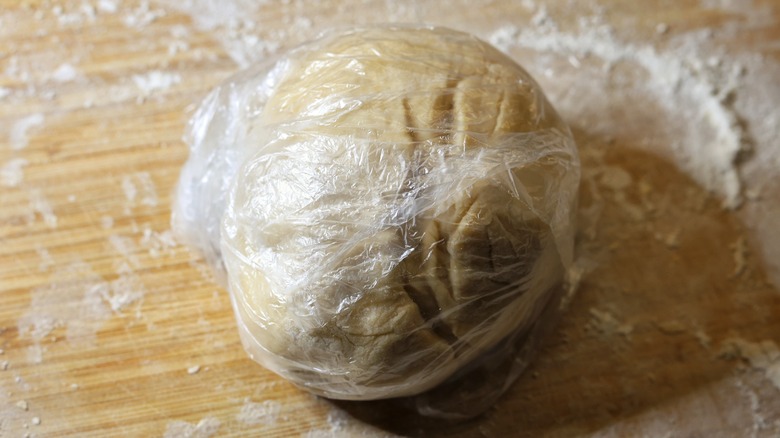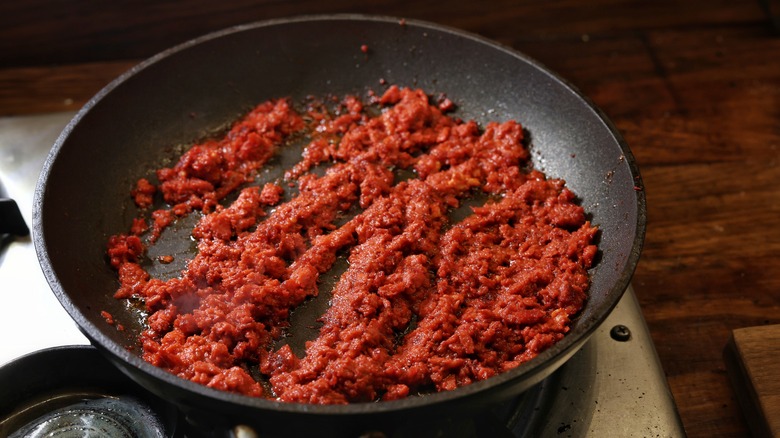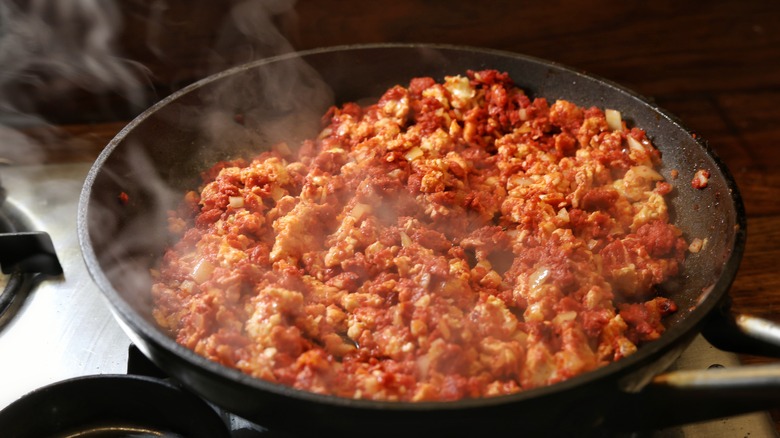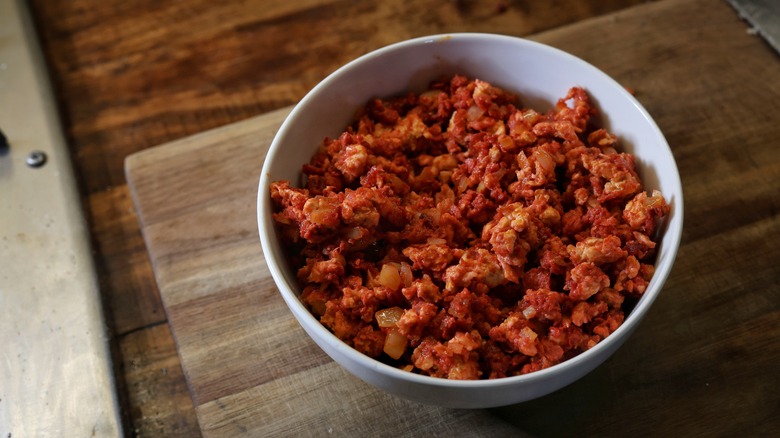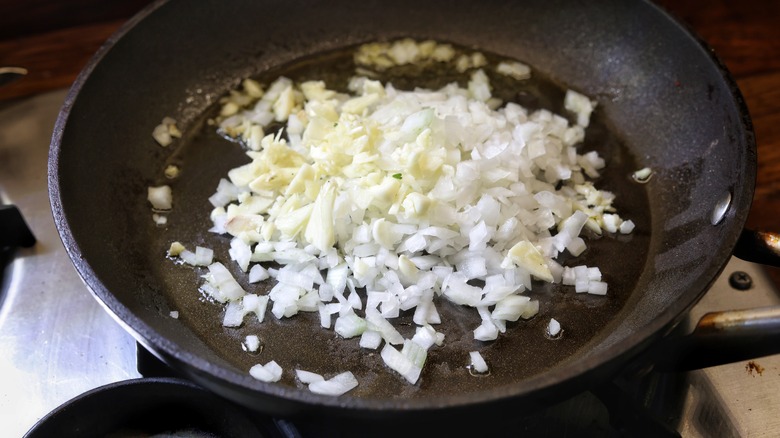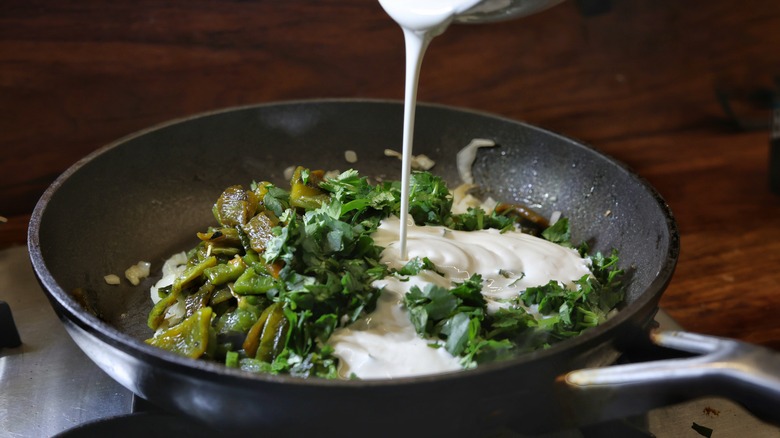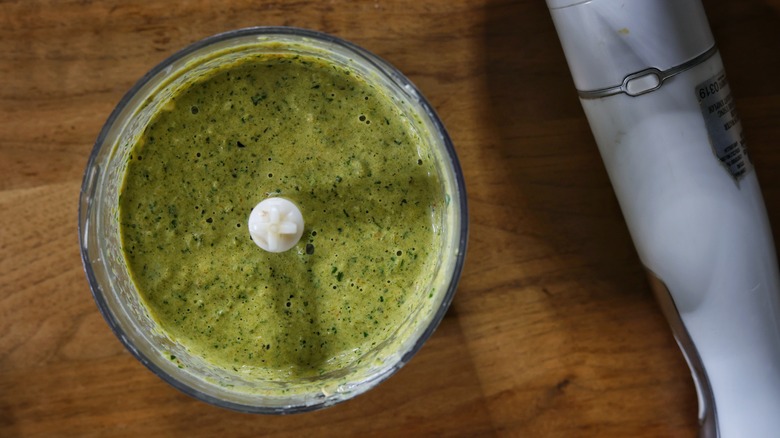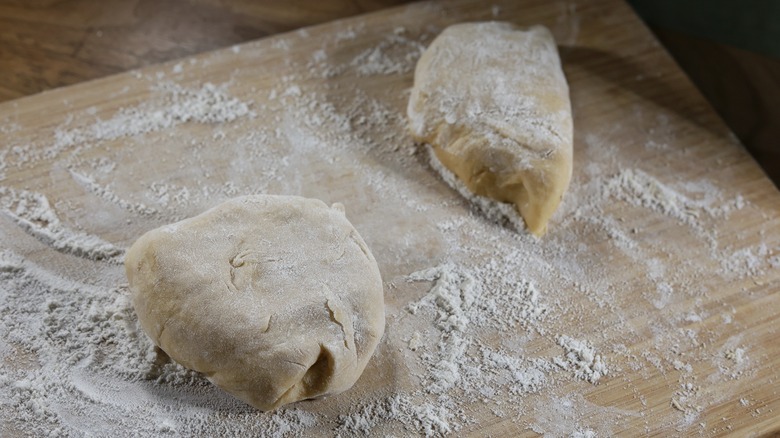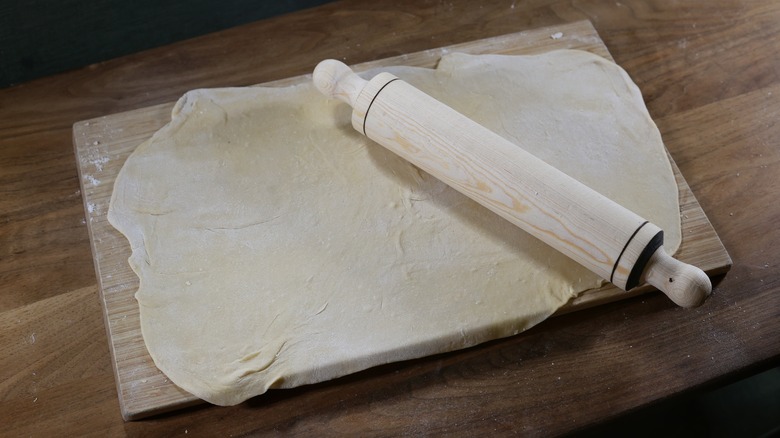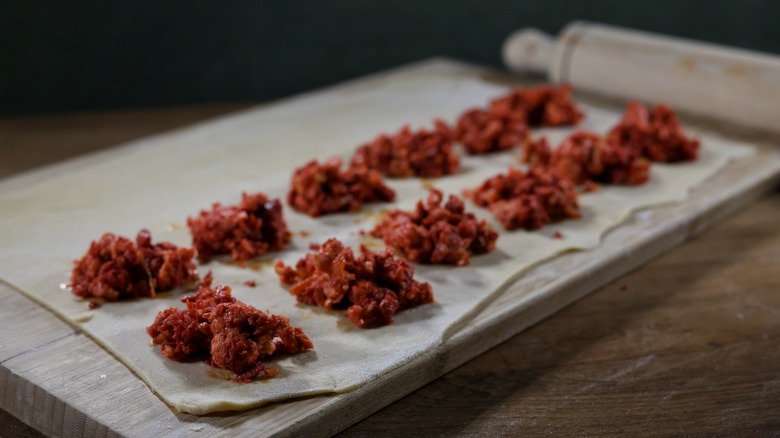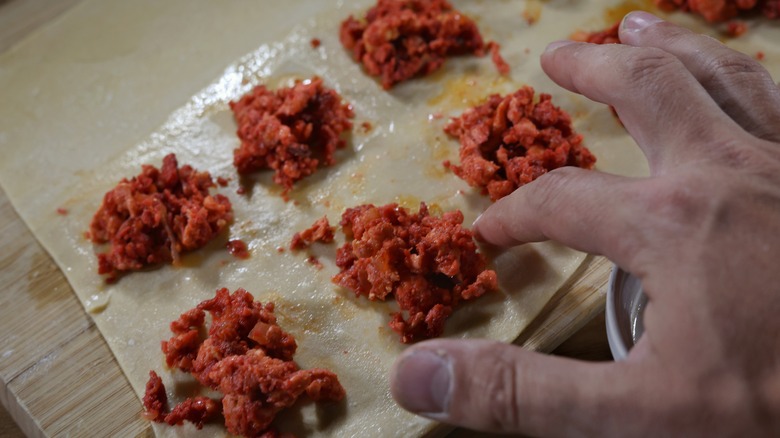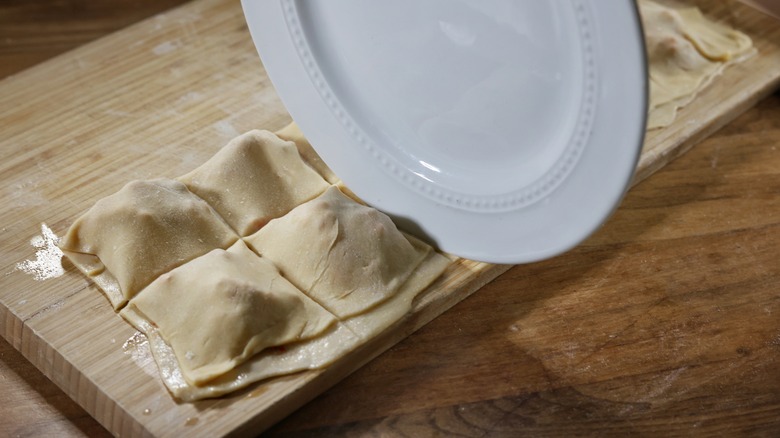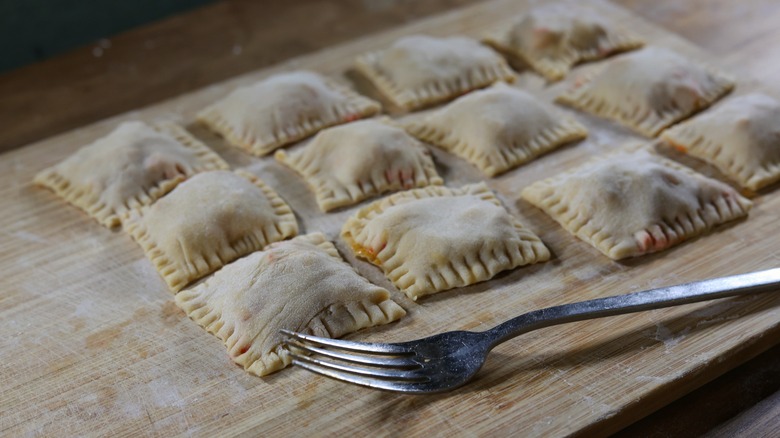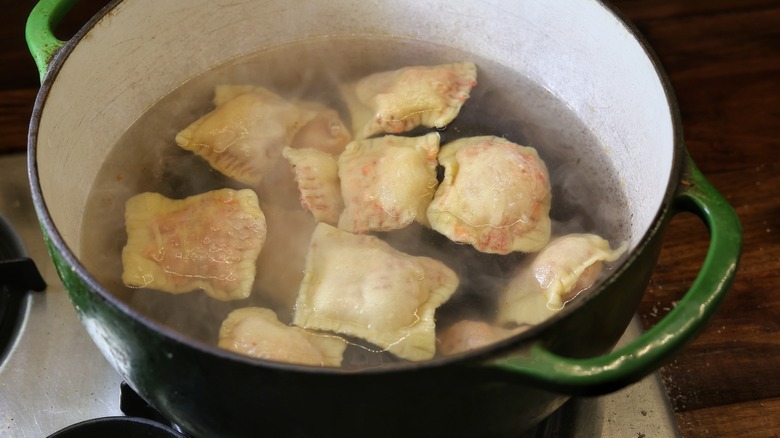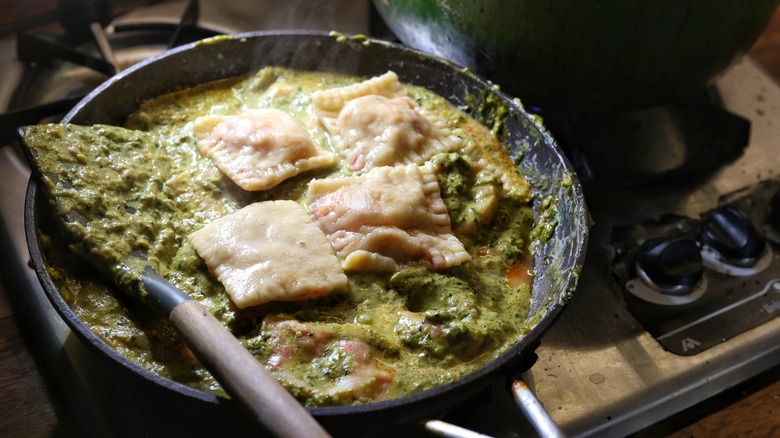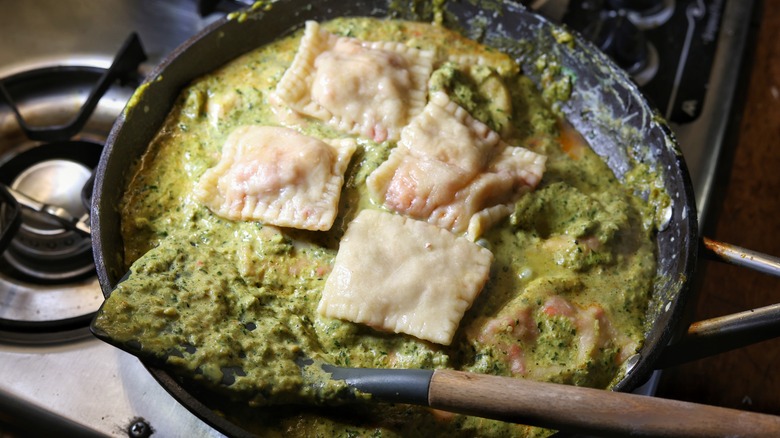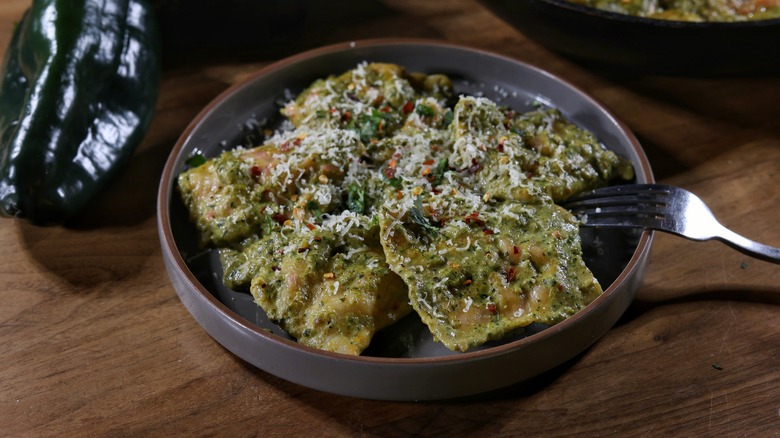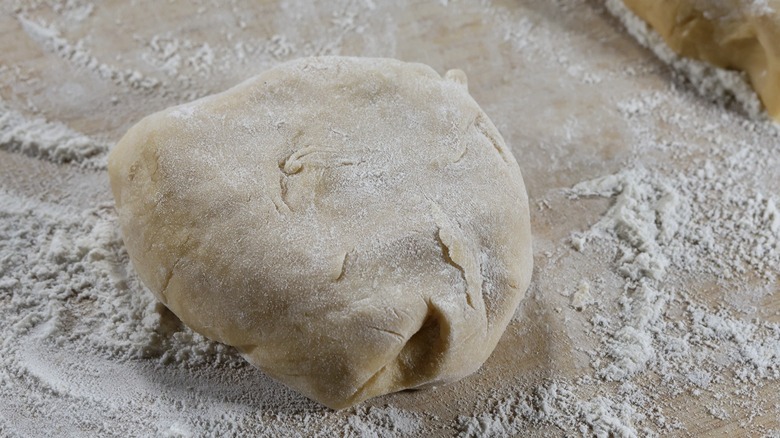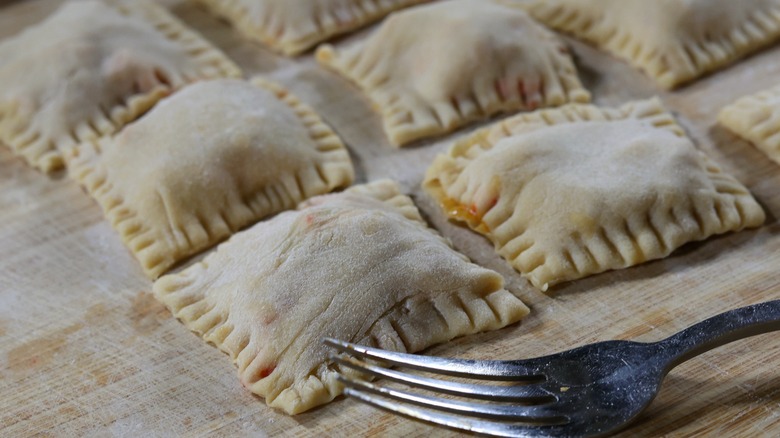Chicken And Chorizo Ravioli With Poblano Cream Recipe
Nothing beats the joy of a truly scratch-made meal, an afternoon spent in the kitchen turning a recipe with simple ingredients into top-notch cuisine. Sitting down in the evening to a meal that you made every bit of — pasta, filling, and sauce — is a deeply rewarding experience. And while it is never easy to craft such a meal, this recipe is a labor of love, and is more than worth the effort.
With a unique combination of Mexican flavors and Italian techniques, this recipe puts a new spin on a familiar favorite. Delicate packets of homemade pasta are stuffed with bold chorizo and tender chicken before being paired with a luscious cream sauce rich with the flavors of cilantro and roasted poblano peppers. It is the sort of meal that you'll think about for weeks, the sort of meal that's too much work to have every day. But once you taste it, you'll find yourself making time for this ravioli. So next weekend, instead of pot roast or red sauce, give this a try instead.
Gather the ravioli ingredients
For this recipe you will need poblano peppers, flour, salt, eggs, chorizo, chicken, onion, garlic, olive oil, cilantro, white wine vinegar, and cream. Once you have brought those ingredients together you can start roasting, kneading, and sauteeing your way to a delicious meal.
Step 1: Roast the peppers
Roast the poblanos for the sauce: This can be done on a hot grill, under a broiler, or directly on a gas stove. Cook, turning occasionally, until the skin is wrinkly and black, a few minutes on each side.
Step 2: Cool the peppers
Once black on all sides, remove the peppers to a cutting board to cool.
Step 3: Remove the skins
When the poblanos are cool to the touch, gently slide the skins off with your fingers or a knife.
Step 4: Remove stems and seeds
Chop off the stems, slice the peppers open, and scrape out seeds.
Step 5: Dice the peppers
Dice roasted poblanos and set aside.
Step 6: Start the pasta
Make the pasta: Mix together the flour and salt and create a well in the center for the eggs and warm water.
Step 7: Form a dough
Mix egg and water mixture with a fork, slowly incorporating flour into the center until a dough forms. Knead dough, adding flour or water as needed, until it's soft and slightly tacky, around 3 minutes.
Step 8: Rest the dough
Wrap the dough in plastic and allow it to rest at room temperature for at least 30 minutes.
Step 9: Start the filling
While the dough is resting, make the filling: Add the chorizo to a skillet over medium-high heat and cook for 2 to 3 minutes, until much of the fat is rendered.
Step 10: Add the chicken and vegetables
Add the chicken, onion, and garlic and cook for another 3 to 4 minutes, until the vegetables are soft and the chicken is cooked through. Add salt to taste.
Step 11: Cool the filling
Remove the filling to a bowl and cool to room temperature.
Step 12: Start the sauce
Make the sauce: Add the olive oil, onion, and garlic to a large skillet over medium heat. Cook until the vegetables are softened, about 4 to 5 minutes.
Step 13: Add the peppers and cream
Reduce the heat to medium-low and add the roasted poblanos, cilantro, and cream. Simmer for 5 minutes.
Step 14: Puree the sauce
Once the sauce has simmered, remove from the heat and puree in a food processor or blender. Add the vinegar and salt, to taste, then return it to the pan.
Step 15: Start making ravioli
Make the ravioli: Unwrap the pasta dough and cut in half. Set one half aside.
Step 16: Roll out half the dough
Roll the other half of the dough very thin, around ⅛-inch thick, flouring often to keep from sticking. The rolled dough should be about 2 feet wide and 1 foot tall.
Step 17: Dole out the filling
Spoon the filling onto the lower half of the dough in evenly-spaced 1 tablespoon amounts. Be sure to leave room between spoonfuls for the edges of the ravioli.
Step 18: Wet the edges
Using a brush or just your finger, wet the pasta between each ravioli with water to ensure the top and bottom stick.
Step 19: Fold and cut
Carefully fold over the top half of the pasta so that the corners match up and all of the ravioli are covered. Push out any air between the filling with the edge of a plate to crimp them closed.
Step 20: Crimp and decorate
Press the edges of the ravioli with the tines of a fork to decorate and provide an extra crimp. Once finished, repeat the process with the second half of the dough and filling, rerolling any scraps.
Step 21: Boil the ravioli
Bring a large pot of well-salted water to boil and return the skillet of sauce to the stove over low heat. Add the ravioli to the water, about 6 to 8 at a time, being careful to not crowd the pot. Boil for around 2 minutes or until the pasta begins to float.
Step 22: Back to the sauce
Scoop the pasta out with a slotted spoon and add directly into the sauce.
Step 23: Toss to coat
When all of the ravioli are in the sauce, toss to coat evenly.
Step 24: Garnish and serve
Serve hot, garnished with Parmesan cheese, finely chopped cilantro, and crushed red pepper, if using.
What are some tips on working with fresh pasta dough?
One could spend a lifetime perfecting homemade pasta, but getting started is actually quite simple. Pappardelle may be best for your first foray into fresh pasta, but regardless of what you choose, here are a few things to focus on.
Rest the dough: After kneading the dough it's important to rest it for at least 30 minutes. This period relaxes the gluten, which makes the dough more elastic and easier to roll. When it comes time to stretch the top layer of dough over your painstakingly-placed ravioli filling, you'll be thankful for that extra elasticity.
Roll evenly: Uniformly rolled pasta cooks evenly and produces a beautiful final plate. A pasta maker is the easiest way to achieve perfectly uniform pasta, but nonnas have been doing it for many years with nothing but a rolling pin and an eye for detail.
Flour often: Perfect, thin pasta dough requires plenty of kneading and rolling. Without a well-floured workspace, kneading and rolling quickly becomes sticking and scraping. Before you start, lightly flour the dough and anything it will come into contact with. Whenever the pasta sticks, sprinkle more flour over.
While there are plenty of mistakes to avoid with fresh pasta, it doesn't need to be an intimidating task. Like anything in the kitchen, all it really takes is a good recipe and a bit of trial and error.
How do I freeze ravioli?
Making homemade ravioli is a labor-intensive venture, but not only do they make a delicious dinner on the night you first prepare them, they can also be stored in the freezer, ready for a quick meal anytime. Once you see how easy it is to freeze ravioli and to cook frozen ravioli, you'll definitely be making a double batch.
To freeze ravioli, begin with uncooked pasta. Cooked pasta does not freeze well, with changes occuring in the starches, so it is better to freeze before cooking. Lay the ravioli you wish to freeze in a single layer on a floured baking sheet. Place the sheet in the freezer and allow them to freeze solid. Once the ravioli are thoroughly frozen, they can be moved to a bag or airtight container for more convenient storage. Just make sure to remove as much air as possible from the bag to prevent freezer burn.
When it comes time to cook those frozen ravioli, there is no need to thaw them. They can be tossed straight from the freezer into a pot of salted water, following the same cooking methods as the recipe above, making an elegant dinner an absolute walk in the park.
Chicken and Chorizo Ravioli With Poblano Cream Recipe
The classic stuffed pasta from Italy gets filled and sauced with Mexican flavors to create a truly memorable meal, and one you made from scratch.
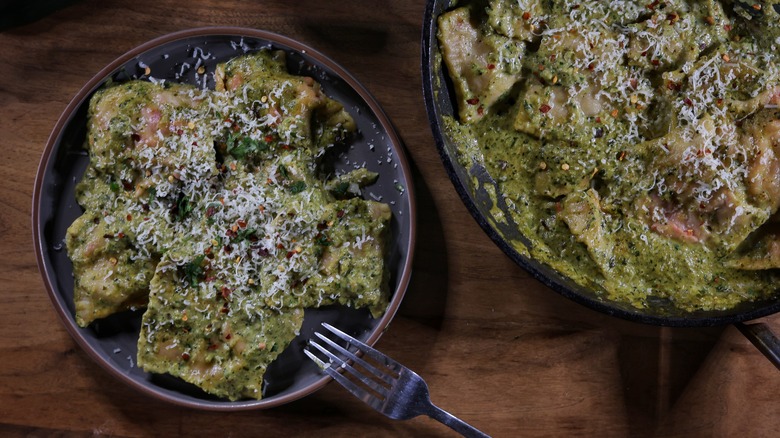
Ingredients
- For the sauce
- 2 poblano peppers
- 2 tablespoons olive oil
- ¾ cup diced onion
- 3 cloves garlic, minced
- ½ cup roughly chopped cilantro
- 1 cup heavy cream
- ½ teaspoon white wine vinegar
- Salt, to taste
- For the pasta
- 2 cups all-purpose flour
- ½ teaspoon salt
- 2 eggs
- ¼ cup warm water
- For the filling
- 8 ounces chorizo
- 8 ounces ground chicken
- ½ cup minced onion
- 2 cloves garlic, minced
- Salt, to taste
Optional Ingredients
- Parmesan cheese, for garnish
- Crushed red pepper, for garnish
- Additional chopped cilantro, for garnish
Directions
- Roast the poblanos for the sauce: This can be done on a hot grill, under a broiler, or directly on a gas stove. Cook, turning occasionally, until the skin is wrinkly and black, a few minutes on each side.
- Once black on all sides, remove the peppers to a cutting board to cool.
- When the poblanos are cool to the touch, gently slide the skins off with your fingers or a knife.
- Chop off the stems, slice the peppers open, and scrape out seeds.
- Dice roasted poblanos and set aside.
- Make the pasta: Mix together the flour and salt and create a well in the center for the eggs and warm water.
- Mix egg and water mixture with a fork, slowly incorporating flour into the center until a dough forms. Knead dough, adding flour or water as needed, until it's soft and slightly tacky, around 3 minutes.
- Wrap the dough in plastic and allow it to rest at room temperature for at least 30 minutes.
- While the dough is resting, make the filling: Add the chorizo to a skillet over medium-high heat and cook for 2 to 3 minutes, until much of the fat is rendered.
- Add the chicken, onion, and garlic and cook for another 3 to 4 minutes, until the vegetables are soft and the chicken is cooked through. Add salt to taste.
- Remove the filling to a bowl and cool to room temperature.
- Make the sauce: Add the olive oil, onion, and garlic to a large skillet over medium heat. Cook until the vegetables are softened, about 4 to 5 minutes.
- Reduce the heat to medium-low and add the roasted poblanos, cilantro, and cream. Simmer for 5 minutes.
- Once the sauce has simmered, remove from the heat and puree in a food processor or blender. Add the vinegar and salt, to taste, then return it to the pan.
- Make the ravioli: Unwrap the pasta dough and cut in half. Set one half aside.
- Roll the other half of the dough very thin, around ⅛-inch thick, flouring often to keep from sticking. The rolled dough should be about 2 feet wide and 1 foot tall.
- Spoon the filling onto the lower half of the dough in evenly-spaced 1 tablespoon amounts. Be sure to leave room between spoonfuls for the edges of the ravioli.
- Using a brush or just your finger, wet the pasta between each ravioli with water to ensure the top and bottom stick.
- Carefully fold over the top half of the pasta so that the corners match up and all of the ravioli are covered. Push out any air between the filling with the edge of a plate to crimp them closed.
- Press the edges of the ravioli with the tines of a fork to decorate and provide an extra crimp. Once finished, repeat the process with the second half of the dough and filling, rerolling any scraps.
- Bring a large pot of well-salted water to boil and return the skillet of sauce to the stove over low heat. Add the ravioli to the water, about 6 to 8 at a time, being careful to not crowd the pot. Boil for around 2 minutes or until the pasta begins to float.
- Scoop the pasta out with a slotted spoon and add directly into the sauce.
- When all of the ravioli are in the sauce, toss to coat evenly.
- Serve hot, garnished with Parmesan cheese, finely chopped cilantro, and crushed red pepper, if using.
Nutrition
| Calories per Serving | 804 |
| Total Fat | 49.8 g |
| Saturated Fat | 21.6 g |
| Trans Fat | 0.9 g |
| Cholesterol | 231.7 mg |
| Total Carbohydrates | 59.8 g |
| Dietary Fiber | 3.0 g |
| Total Sugars | 5.3 g |
| Sodium | 830.9 mg |
| Protein | 29.7 g |
